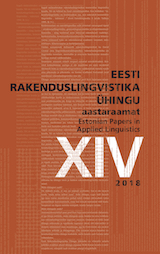Suulisest ja kirjalikust tõlkest lõppteksti ja tõlkeprotsessi põhjal
Some topics in translation and interpreting research
Author(s): Marju Taukar, Reeli Pärn, Anna Kaplina, Marianne Ots, Gristel PihlakasSubject(s): Lexis, Semantics, Comparative Linguistics, Translation Studies
Published by: Eesti Rakenduslingvistika Ühing (ERÜ)
Keywords: translation of applied texts; simultaneous translation; written translation; translation process; demonstrative pronouns; cultural items; self-repair; Estonian;
Summary/Abstract: The article describes some findings of a pilot study in the field of translation and interpreting studies. 4 translators and 5 interpreters translated the same source text from English into Estonian. Their translation process was recorded either as an audio recording (for interpreters) or screen recording (for translators) and all texts were collected. As interpreting research is so far basically missing in Estonia and translation process research is also in the beginning stages, the study is to a large extent exploratory and tentative. We looked into the use of pronouns, of which only demonstrative pronouns showed a difference in usage that could not be explained by the nature of the task. We also analysed whether there was any use of literal translation as a strategy, also to understand how the translator’s and interpreter’s mind works to find solutions for certain translation problems. The translation of cultural items being the most difficult part in the translation task used, we studied the problem-solving strategies and decisions translators and interpreters made. The translation process data was most intensively used to study self-corrections in the translator’s work process. This revealed some interesting patterns in the translator’s working habits, which could definitely be elaborated and researched further. All in all, we find that it makes a lot of sense to study these two areas of translation together and the best way to encourage it would be compiling a proper (longterm) corpus of product and process data. The advances in such research would be most appreciated in the didactic environment but it would also be an important addition to translation studies and translation tools development.
Journal: Eesti Rakenduslingvistika Ühingu aastaraamat
- Issue Year: 2018
- Issue No: 14
- Page Range: 197-214
- Page Count: 18
- Language: Estonian

